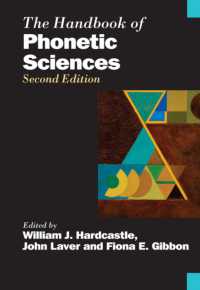- ホーム
- > 洋書
- > 英文書
- > History / World
Full Description
The Great Irish Famine of the 1840s left a profound impact on Irish culture, as recent ground-breaking historical and literary research has revealed. Less well documented and explored, however, is the relationship of the Famine and related experiences (hunger, migration, eviction, poverty, institutions and social memory) to visual and material cultures. This book aims to explore how the material and visual cultures of Ireland and its diaspora (including painting, engraving, photography, devotional objects, ritual, drama, film, television, and graphic novels) intersect with the multiple impacts and experiences of the Famine. In tracing the Famine's impact in Ireland, Northern Ireland, and across the diaspora over almost two centuries, it adopts transgenerational as well as transnational approaches to the subject of cultural memory.
Interest in the Famine has increased rather than declined since its sesquicentenary, acquiring new relevance in the wake of Ireland's recent economic collapse and the international contemporary refugee crisis, with which frequent parallels have been drawn. This book arrives in the midst of the Decade of Centenaries, the sequence of key commemorations in Ireland and Northern Ireland that has attracted widespread international public attention. As such, its essays resonate with current developments in Irish cultural history, commemoration and memory, and advances new approaches to studies of memory and materiality.
Contents
Figure/caption list
Foreword: by Oona Frawley (University of
Maynooth)
Introduction: Famine Memory and its
Industries: Genealogies of Representation by Emily Mark-FitzGerald (University
College Dublin)
Section I: Witness and Representation:
Contemporaneous Depictions of Famine
1. The Bond that Knit the Peasant to the
Soil: Rural Lore and Superstition in the Work of Daniel Macdonald by Niamh
O'Sullivan (Ireland's Great Hunger Museum, Quinnipiac University)
2. HB's Famine Cartoons: Satirical Art in a
Time of Catastrophe by Peter Gray (Queen's University Belfast)
3. The Famine Diaries and Sketches of John
Plunket Joly by Ciaran Reilly (Maynooth University)
4. Mortuary Spectacles: The Genealogy of
Images of the Famine Irish Coffin Ships and Fever Sheds by Jason King
(Independent scholar)
Section II: Negotiating Form: Famine /
Post-Famine Modalities and Media
5. 'Thus Crucifixes Became the Norm':
System, Affect, and Display in Post-Famine Catholicism by Lisa Godson (National
College of Art and Design)
6. 'This Most Humane Commerce': Lace-making
During the Famine by Melissa Fegan (University of Chester)
7. Art and the Post-Famine Irish Diaspora
in America by Fintan Cullen (University of Nottingham)
8. The Greatest Famine Film Never Made by Bryce
Evans (Liverpool Hope University)
Section III: Legacy: Postmemory and
Contemporary Visual Cultures
9. Tom Murphy and Druid Theatre's Famines:
Developing Images and Contexts, 1984 and 2012 by Shelley Troupe (Maynooth
University)
10. Overcoming Amnesia? Memorializing
Finland's 'Great Hunger Years' by Andrew G. Newby (Aarhus University)
11. Evictions on the TV Screen: the Visual
and Narrative Legacies of the Great Famine in The Hanging Gale by Marguérite
Corporaal (Radboud University)
12. Gone to Amerikay: Famine Postmemory,
the Irish Diaspora and the Graphic Novel by Dawn Miranda Sherratt-Bado
(Independent scholar)
References








